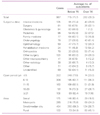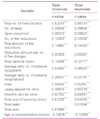Abstract
Greater than its influence on the medical practitioner's individual ability is the National Health Insurance System's influence on the management of medical practitioners' offices in Korea. However, despite the important effect health insurance exerts on the income of medical clinics, recently, the financial difficulties of medical clinics have often become an issue, and financial difficulty has been aggravated as much as a solution has been sought. The current state of the overall management of medical clinics was investigated to understand the factors influencing the sales and expenses in their management. A questionnaire was completed by 1,009 physicians registered in the Korean Medical Association who were participating in a statistical extraction course. As a result of the study, the factors influencing the total revenue and total expenditures of medical clinics, such as increases in the total number of doctors, increasing numbers of outpatients, the size of the medical office, medical disputes, and clinical specialties (based on the first medical treatment) showed statistical significance. In conclusion, in order to improve medical clinic management, a health insurance medical fee should be more reasonably fixed, a medical transfer system should be reestablished, and a cooperative strategy should be created for medical clinics and general hospitals in order to attract patients. As a result, low cost and highly efficient medical services could be provided and the satisfaction of patients improved.
Figures and Tables
Table 1
Distribution according to respondents' characteristics, clinic type per & clinical area of clinics

References
1. National Health Insurance Corporation. 2010. cited 2010 Nov 20. Seoul: National Health Insurance Corporation;Available from: http://www.nhic.or.kr.
2. Im GJ. Management analysis of clinics in 2003. Healthc Policy Forum. 2003. 1:158–165.
3. National Health Insurance Corporation. 2005. cited 2010 Nov 20. Seoul: National Health Insurance Corporation;Available from: http://www.nhic.or.kr.
4. Oh CS. Status and vitalization plan of primary medical institutions. Healthc Policy Forum. 2003. 1:66–183.




 PDF
PDF ePub
ePub Citation
Citation Print
Print














 XML Download
XML Download